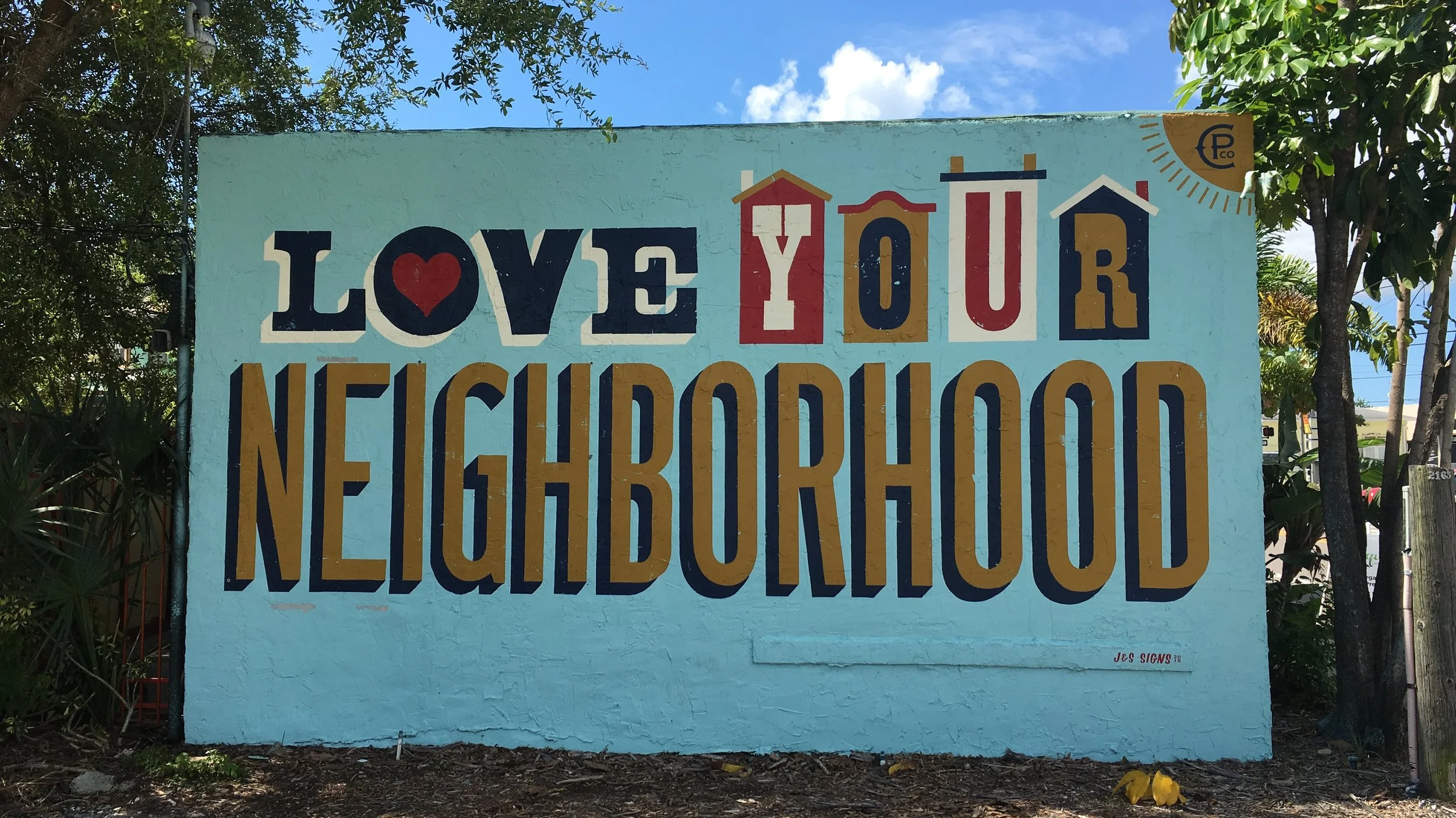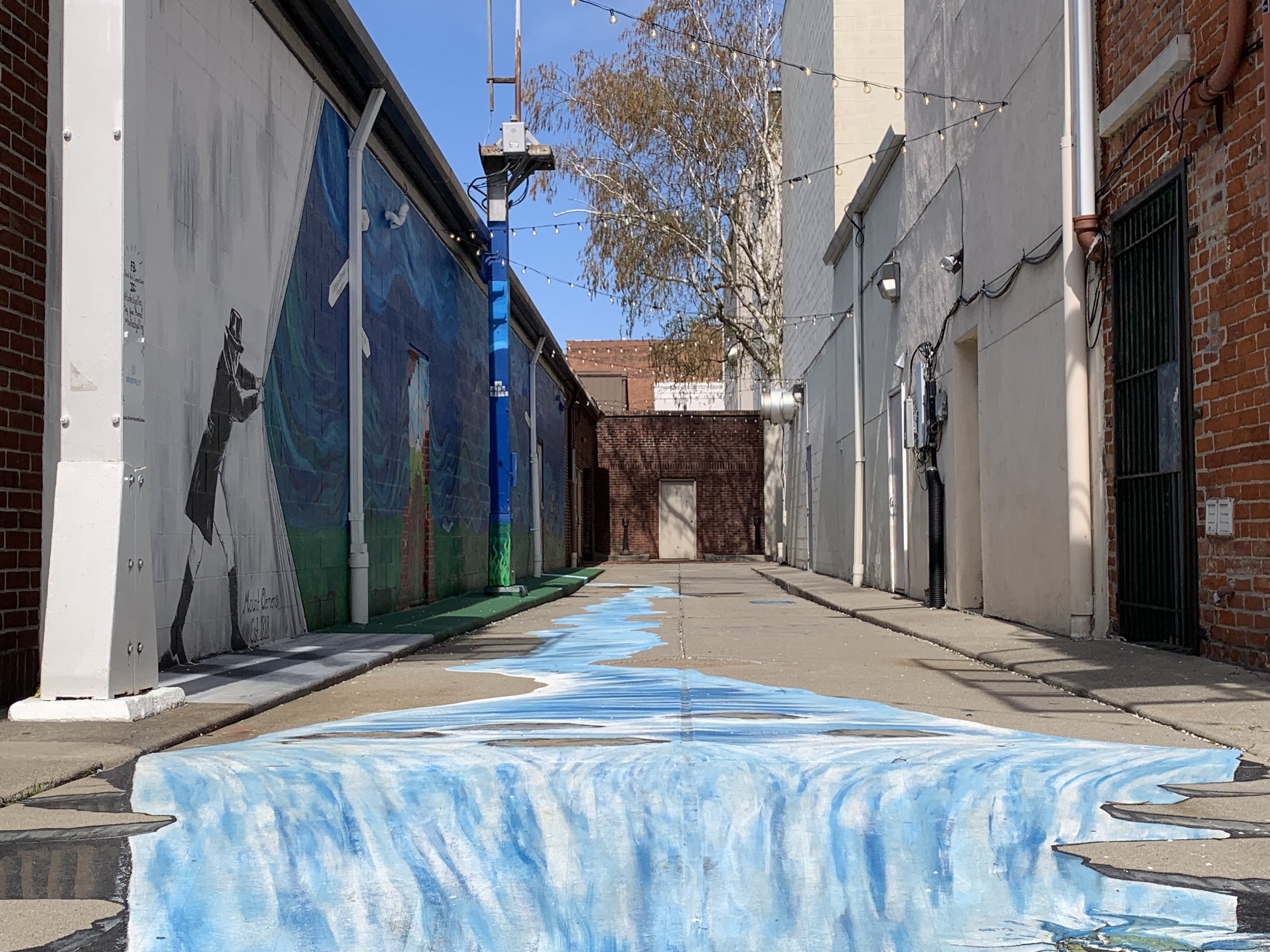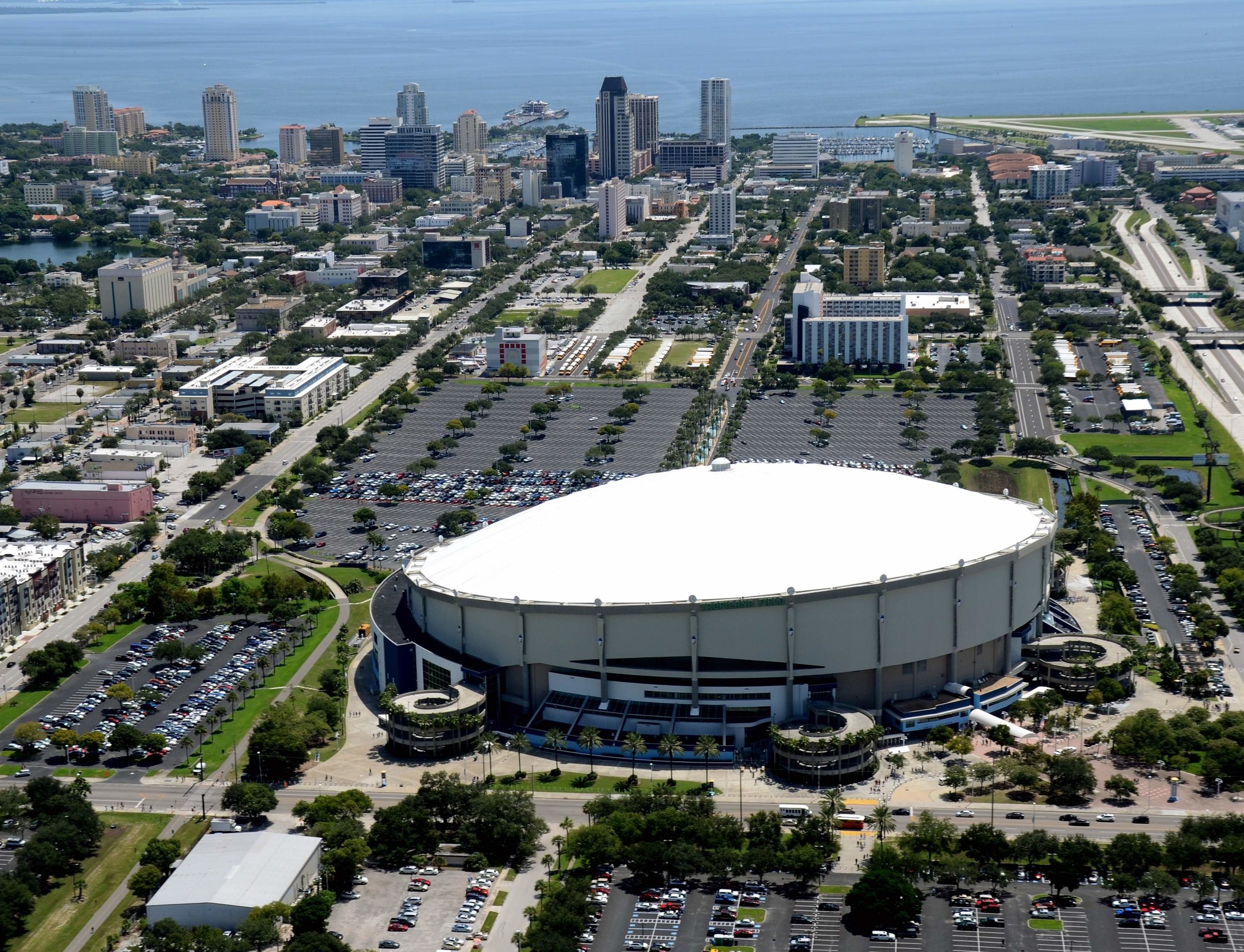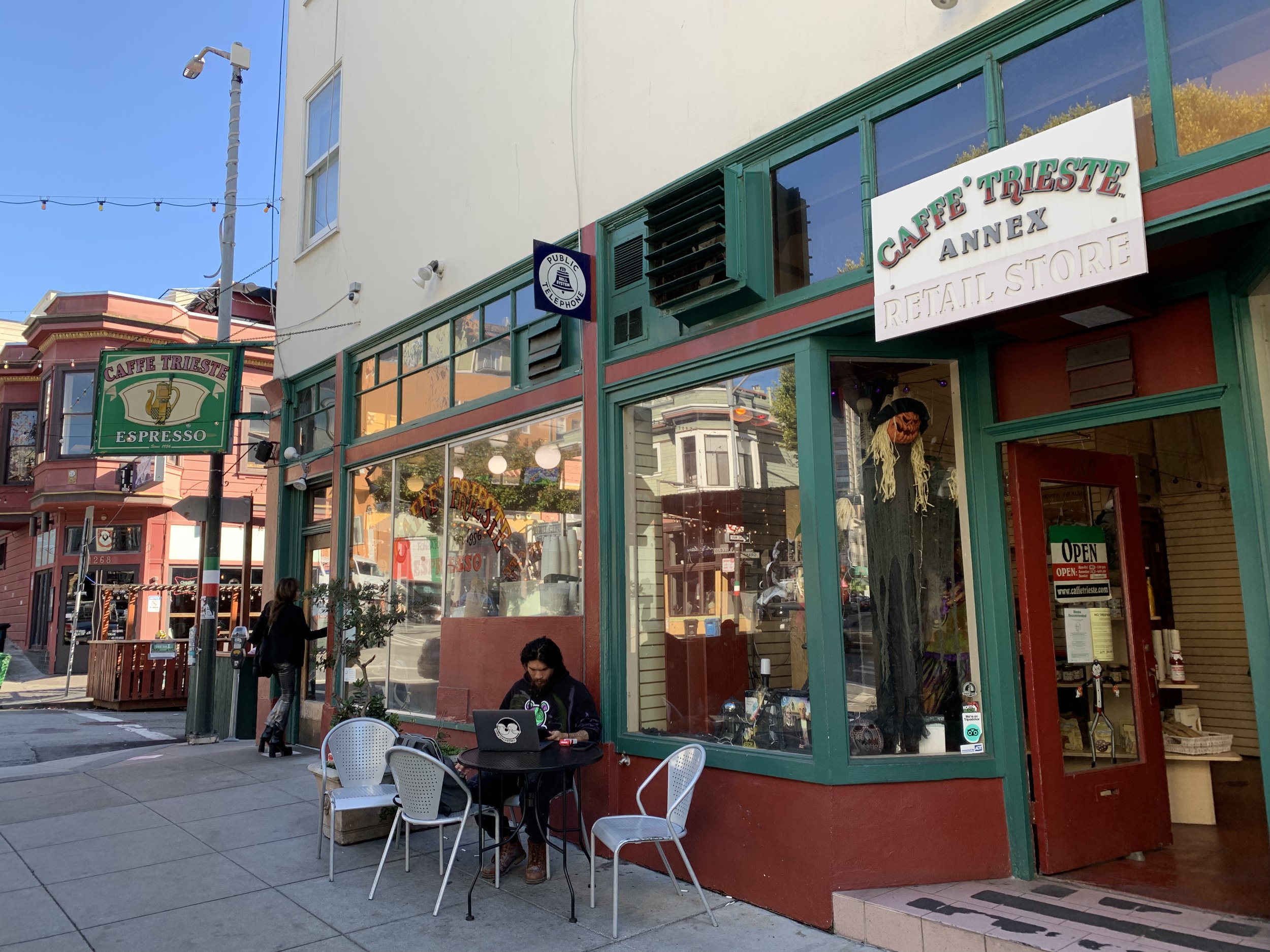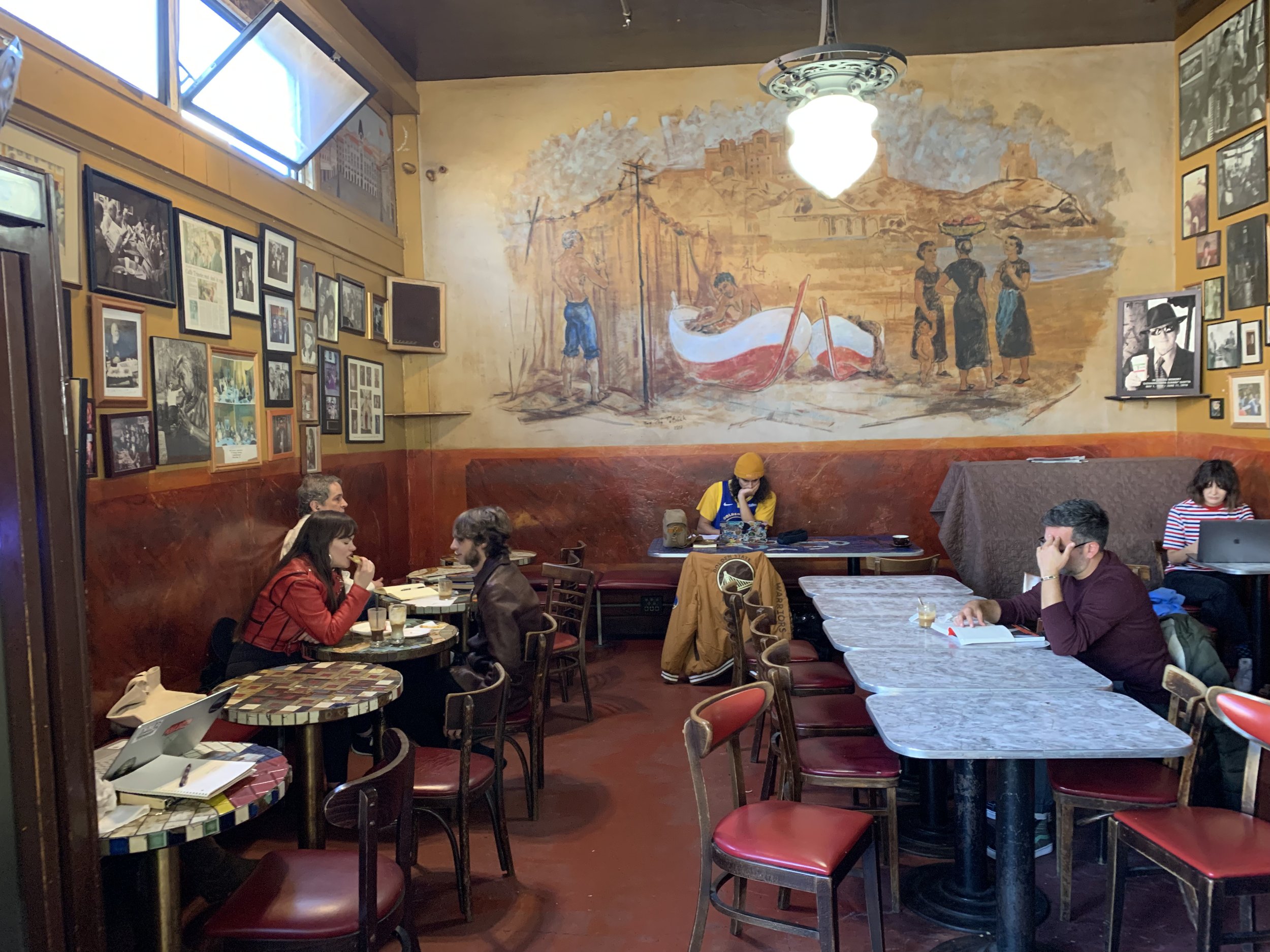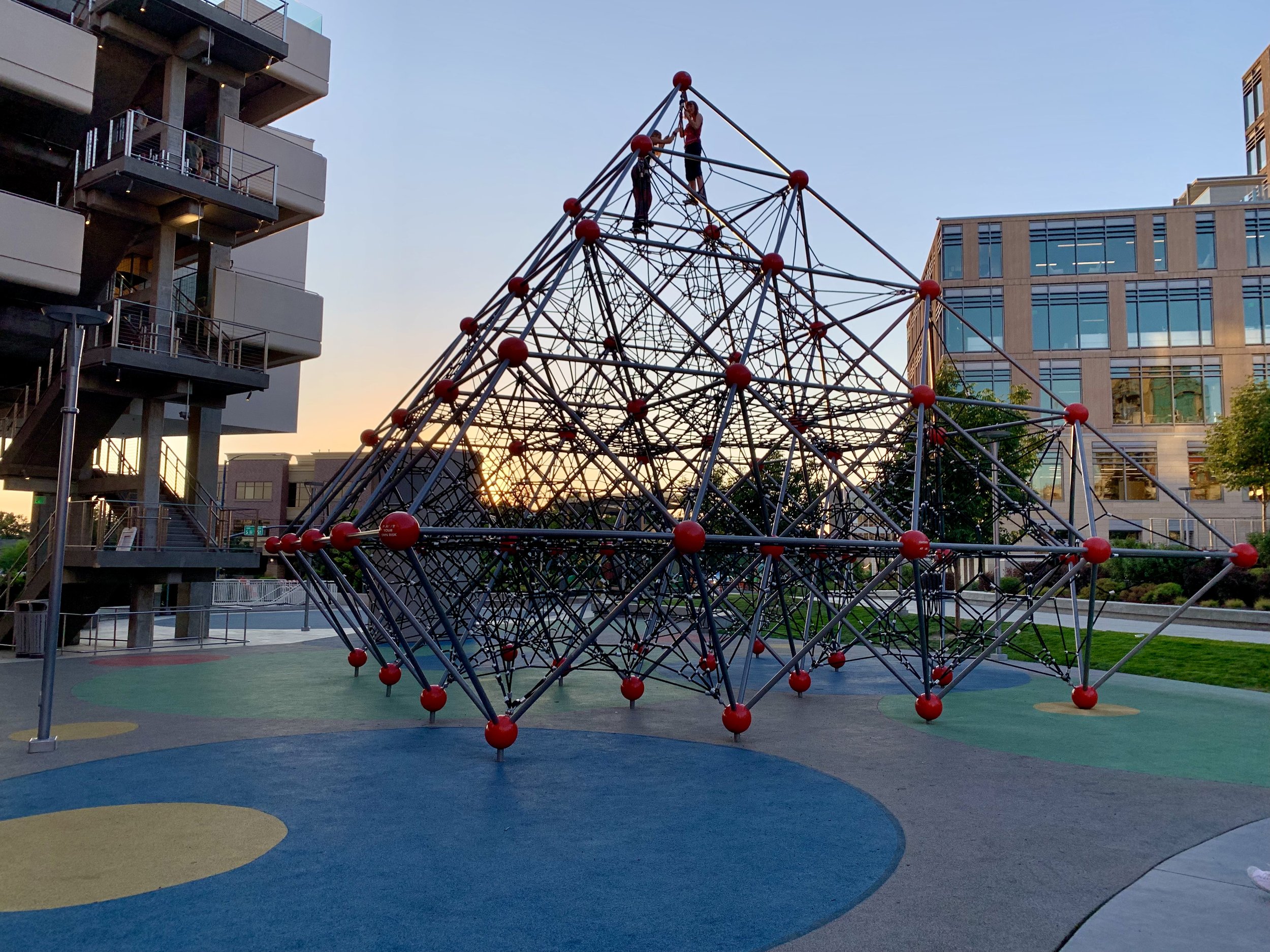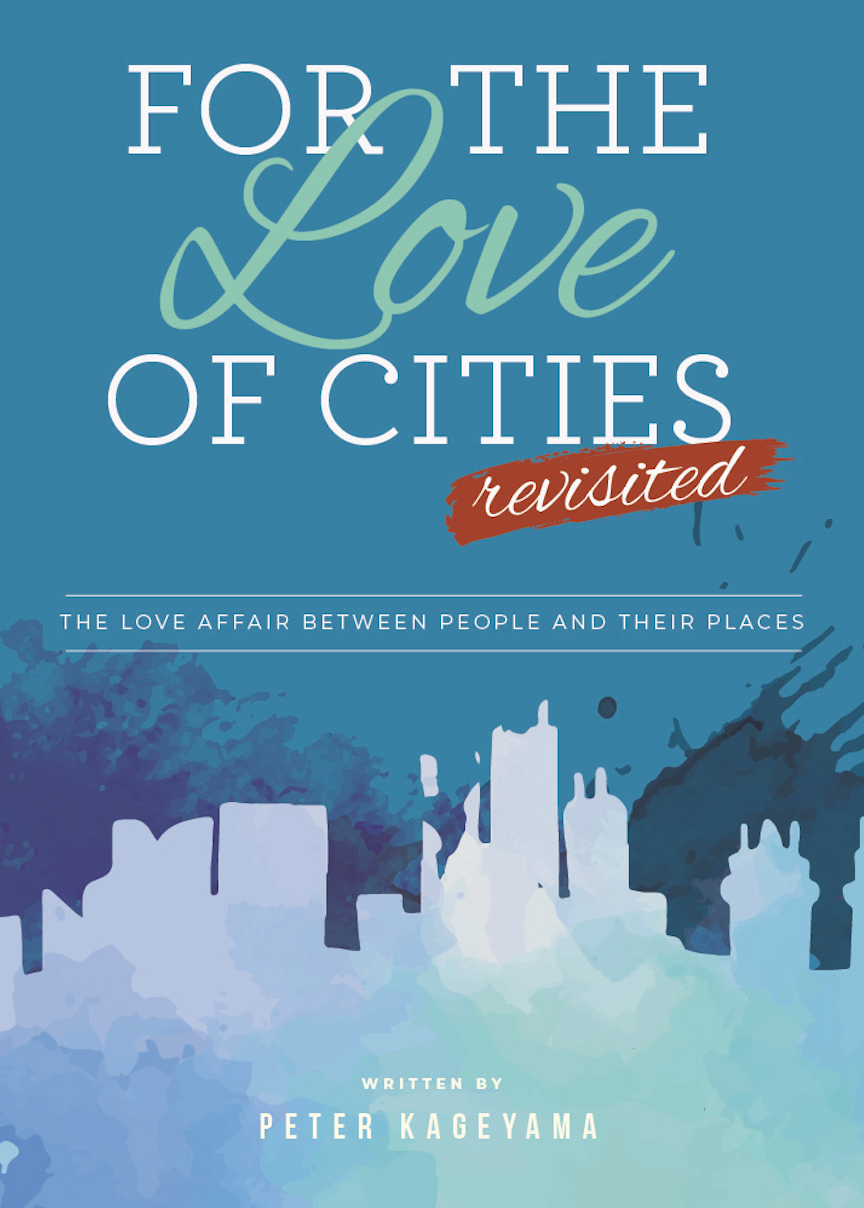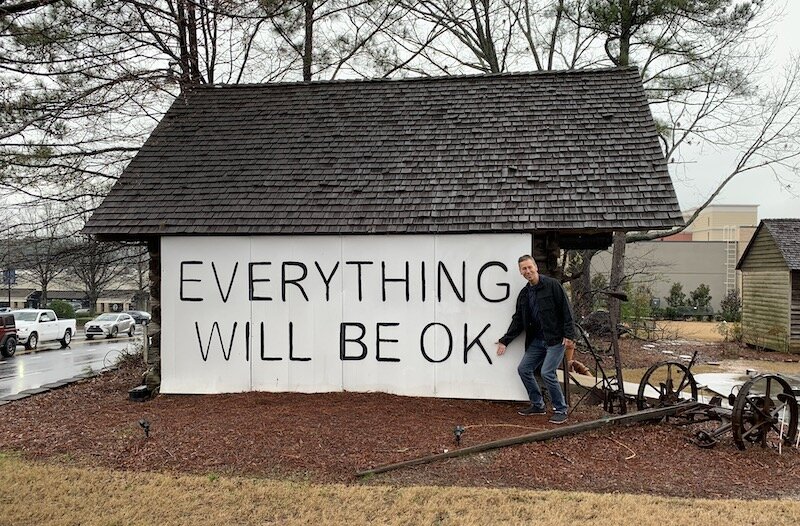With the reputation that Asheville, NC enjoys, it seemed completely in character to see this street busker in their downtown. I noted lots of dogs there as well!
Mural - Mount Clemens, Michigan
This clever mural actually leads you down the alley.
Tropicana Field Redevelopment
This piece originally appeared in St. Pete Catalyst - 11/28/22
“I love St. Petersburg!” You hear that a lot around our city. It is a phrase the comes unbidden from residents and visitors alike. It carries with it the promise of today and of many better days to come. It also raises the bar for those who would build here, create here and live here. When we love something, we are protective of it and we expect only the best for it.
That is the ultimate challenge for the Trop site – to do something beyond technical excellence, beyond aesthetic beauty, beyond greatness, to do something worthy of that which we love.
The 87-acre site has been called a “generational project,” and it clearly is. That means it will set the tone and timbre of all development for a generation. It takes the hopes, dreams and expectations of the city and projects them forward for years to come. This project becomes the benchmark by which all others will be judged.
Because of that, it has to be more sustainable and more environmentally responsible than anything before because it’s not setting the ceiling of those expectations, but the floor. It must have more natural greenspace and parks as the past few years have proven how important that natural third space is to our community’s health and well-being. And it must have more affordable housing than some would think necessary or even possible.
Affordability is not just an economic conversation. To be affordable is to be accessible. It is the ability to be able to live in the heart of your city, to be part of the community and feel that the city, especially downtown is yours and you are an active participant in what makes it great. Something as central and important as downtown must be available and accessible by more people than less. Downtown is everyone’s neighborhood, yet downtowns have become increasingly expensive across the country. The vibrant downtowns of the future cannot be economic islands that only the wealthy can access. The future of our city will be in large part determined by the example set in this generational opportunity.
While no one project can rebalance scales that have generationally tipped, a project of this scope can and should move the needle towards that goal and set the level of expectation that more projects will aspire to, and make downtown an open, equitable and possible option for the next generation. To set the bar any lower is to say to the next generation, your role is to serve here, to commute here, to taste the fruits of this project, but to be relegated to being a tourist in your own city.
Beyond the expected and required expertise in all manner of architecture, planning, development and design, this project requires something different. It requires empathy. Empathy for all economic strata, for all ages, for all races, faces, abilities and identities. Empathy for those that do not agree with the project and would oppose the work that is done. It requires deep empathy for the wounds and unfulfilled promises made many years ago. And because of that, the project has the added responsibility of healing a breach in the fabric of our community identity.
There is a Japanese art form called Kintsugi. It is the art of repairing broken pottery with a brightly colored lacquer, that does not hide the breaks, but rather showcases the repaired pieces. It reflects the philosophy of treating the breaks and the repairs as part of the history of that object and not something to hide. In mending those breaks, the strength of the piece becomes even greater and its meaning even more profound.
It feels like this project needs to be infused with that philosophy. So let’s weave together the broken with the new, the past with the future, and make this a project that moves the city, that PROPELS our city forward for the next generation.
This is our city and we love St. Petersburg.
Peter Kageyama is an award-winning author and urbanist, a 29-nine year resident of St. Petersburg, and an advisor on community engagement and activation with Sugar Hill Community Partners.
Classic Third Space - San Francisco, California
Caffe Trieste in the North Beach neighborhood of San Francisco has been a community gathering space since the Beat poets and writers of the 1950’s would gather there for espresso and conversation. Not at all fancy but absolutely a love note.
Tiny Love Note - Portland, Oregon
Mill Ends Park in Portland, Oregon is known as the world’s smallest official city park. For over 60 years, this tiny park has delighted visitors and locals alike.
Adult Sized Fun - Boise, Idaho
Adult sized jungle gym in downtown Boise.
Now Available - For the Love of Cities REVISITED
Now Available - For the Love of Cities REVISITED, published by St. Petersburg Press. Expanded and updated to include the extraordinary events of 2020 and beyond.
For the Love of Cities REVISITED
This year, 2021, marks the 10 year anniversary of the publication of my first book, For the Love of Cities. I can’t believe it has been 10 years! In the midst of the enforced downtime of 2020, it seemed an appropriate time to update and revisit that book. Over the course of 2020, I reread, reviewed, rethought and reimagined the book that set me on this course. And it was a fascinating process!
I re-interviewed several of the key players in the original book and did a “Where are they now” kind of update. I also felt compelled to write some new content that was informed by our collective experience with the pandemic and the massive rise in awareness of social justice issues. 2020 was an extraordinary year that will have implications for our communities for many years to come.
I just handed off the finished manuscript to my publisher, St. Petersburg Press, and we are looking to have the book out late in Q2 of this year. More details will follow, but I am super excited to share this new/old book with you all again!
Everything Will Be OK
In early March, I visited Dunwoody, Georgia. They showed me this lovely mural at the Spruill Center for the Arts. The mural had been done several years before by artist Jason Scott Kofke and was intended to be temporary but the community had fallen in love with that simple yet beautiful statement. In fact, the message had almost become the de facto city slogan and brand.
At the time of my visit, Covid-19 was making the news but still somehow seemed far away. Just a couple weeks later and that all changed. And when it changed, that mural became even more important to Dunwoody and many other communities as well. The pandemic revealed it to be “emotional infrastructure.”
In the early weeks of the pandemic, there was a a lot of fear and uncertainty. People began to share pictures of the mural on their social media platforms and the message started to spread. The CEO of the Arts Center, Alan Mothner and the artist partnered with a local sign maker and they offered small yard signs with that message printed on it. You ordered the sign online and someone from the Arts Center would install it in your yard. The money generated became a fund to support local artists impacted by the pandemic.
Extraordinary circumstances revealed the importance of a simple mural to the community of Dunwoody but it did not stop there. News crews from around the state picked up the story and shared it across the country. This is infrastructure - emotional infrastructure. Certainly I am not going to equate this with a hospital or a medical clinic, but this mural plays a part in the health and well being of the community. Care and feeding of our mental and emotional state is a critical part of what our cities do for us, yet it is often not obvious. And it is often not valued.
I believe one of the important outcomes of these extraordinary times will be that we look at our homes, our neighborhoods and our cities with a new set of eyes. We will remember what was important when we could not travel freely and partake of our places in the usual fashion. We will remember how a simple park became our sanctuary when we had to get out of the house. We will remember the moments of beauty, both natural and man-made, that eased our troubled minds. So when we return our attention to building and developing our places again, we will (hopefully) have new requirements and standards that inform those decisions.
It Started With a T-Shirt
In early December I was visiting my home town of Akron, Ohio. The occasion was a concert that my girlfriend and I were attending in nearby Northfield, Ohio. Part of our trip was me sharing the city with her, which necessitated a trip to Rubber City Clothing.
Rubber City Clothing is a local business that sells apparel and other Akron themed designs. I wrote about them in my first book where I highlighted them and several other similar companies that were in the business of “selling local pride.” RCC has been going strong for over a decade and they exemplify these types of businesses that have tapped into a strong market desire to share love and pride in your city. Others such as STL Style House in St. Louis, Fleurty Girl in New Orleans, Raygun in Iowa and CLE Clothing in Cleveland have become champions of local love in their communities.
On this day in December, Lisa and I were equipping ourselves with Akron and Ohio themed paraphernalia; Lisa is from Toledo and went to Kent State so the Ohio theme worked for both of us. The clerk who helped us was wearing an interesting shirt with a design that I did not recognize. She was wearing this:
I asked her about the story behind the shirt and she told me of the “Fulton Angel” – an iconic, art deco design element on an old building of the east side of Akron. I had grown up in Akron and had been coming back regularly for years but I had NEVER heard about the angel.
In 1929, Daniel Guggenheim (yes, that Guggenheim family) established the Daniel Guggenheim Airship Institute in Akron to study aeronautics. At the time, Akron was home to two of the largest airships in the world – the Akron and the Macon and the institute was adjacent to the airfield that would eventually house the Goodyear blimp. The institute was founded to study airships and included a then state of the art vertical wind tunnel. And in addition to these scientific elements, Guggenheim commissioned a design on the back of the building that faced the landing area for the airships. Dubbed the “Fulton Angel,” she cradled the airships in her protective embrace and this is the art deco design that pilots landing and taking off would see:
As I said, this great story and this gorgeous piece of art and history were entirely new to me! How wonderful to discover something new about your hometown and it all started with a t-shirt! I have said many times that t-shirts are one panel stories and often they can be incredible distillations of our feelings, our perception and the identity of our places. T-shirts are an opportunity to tell your story and to share with the world. When you wear your local story, you never know who is going to see it and maybe learn something amazing about your community!
Remembering Giorgio Di Cicco
On December 22, 2019 my friend and inspiration, Pier Giorgio Di Cicco passed away at his home north of Toronto. He was 70 years old. Giorgio was a Catholic priest and the former poet laureate of the City of Toronto. It was in that capacity that I first met him in late 2005.
I was traveling with my friend and mentor, Charles Landry on a speaking tour that I had helped to arrange and the last stop on the tour was in Toronto. Charles was speaking at the iconic Toronto City Hall in their main council chamber which as more ampitheatre than municipal office. Then Toronto Mayor David Miller spoke first and then invited his poet laureate to the stage to speak. Giorgio had recently been appointed to that position that had largely been seen as symbolic, yet he had already begun to take the role into a more activist space and was a commentator and thought leader for the city. What he said that night changed my life.
With Giorgio in 2012
Speaking in that baritone voice of his, he spoke of something so basic, so elemental that I was stunned to realize that I had not been hearing it in my discourses about cities. He spoke of love. The love we have for our places and for each other. I had been hearing about creativity, innovation, entrepreneurship, economic development, talent attraction and retention but no mention of our emotional life – no mention of love. Today, it seems that our conversations about our places do involve our emotional life and we are using love in the everyday parlance of city making. I would like to believe that I have had a hand in that shift, perhaps giving the necessary nudge of encouragement for people already hungry for this element. If I have had a hand in that, I owe that inspiration to Giorgio. The ideas he shared ignited something in my mind and in my soul that I carry on today. I have been called the “Pied Piper of City Love” and if so, Giorgio is the one who taught me the tune and I will forever be indebted to him.
There are people we meet and are immediately taken with and impressed by their intellect, their charisma, their presence. Yet in this day and age where we are constantly moving and seeing new people and things, even the most impressive people can quickly fade from our consciousness. This is not a commentary on them but rather upon the nature of our lives today. But there are some, a rare few, who not only impress us from the outset, but their ideas, their spirit lingers with us. Giorgio was certainly that kind of person. I engaged with Giogio perhaps a dozen times over 10+ years but I know his spirit will linger with me for the rest of my days, and I will be a better man for it.
The Emotional Infrastructure of Places
“The Emotional Infrastructure of Places” Distills Essence of What Makes Certain Cities So Beloved
Urbanist Peter Kageyama’s new book tackles what’s next in placemaking strategies and explores the emotional components that are essential for communities to thrive today
St. Petersburg, Fla. – (October 7, 2019) – Urbanist Peter Kageyama, the “City Love Guy,” has released his third book in a trilogy that explores the importance of love and emotional engagement with our places. “The Emotional Infrastructure of Places” examines the ecosystem that “co-creators” - people who love their communities – inhabit, and how supporting them and their work can engender connected, emotionally engaged, and thriving places.
“We’re having a national conversation right now about the need to modernize or build our infrastructure,” said Kageyama. “My hope is that we don’t just rush to invest in infrastructure that meets the most obvious needs, but that we look at the psychological and emotional impact of all this infrastructure we need to build. We live with infrastructure for a long time, and it is only over time that the emergent qualities of that infrastructure manifest. We need to be thinking about and planning for those long-term effects.”
“The Emotional Infrastructure of Places” discusses how the smallest things can be used to solve the biggest problems; how solving the problems closest to us creates the possibility of solving intractable problems such as transportation, gentrification and social equity.
In Honor of National Dog Day
My smallest one - Dobby.
In honor of National Dog Day, I have included here an excerpt from my forthcoming new book, The Emotional Infrastructure of Places. This section deals with the increasing importance of dogs in our lives and in our cities.
The Emotional Infrastructure of Places - Canine Infrastructure
As much as we love our cars and our phones, there is perhaps one love that might eclipse that emotional connection. That is our deep and abiding love affair with our dogs, which has dramatically expanded in recent generations, and is necessitating a new conversation and practice around the infrastructure to support our four-footed friends.
“Whoever can solve the dogshit problem can be elected mayor of (the city), even President of the United States,” said iconic San Francisco councilman Harvey Milk in the early 1970s.[i]Milk, best known as a champion of LGBTQ rights, initially came to prominence through the issue of dogs in the city. It was, and is, a quality of life issue for urban residents. Dogs have been living with us in our cities for centuries now, but the recent return to cities, especially downtowns, has brought to the forefront the issue of how we integrate and accommodate these creatures into our lives and our places.
I am a dog owner. Actually, let me clarify that statement—I am a ‘dog parent.’ I now have three lovely, sometimes crazy dogs, and no kids. I dote on the dogs, dressing them up for the appropriate holidays, taking them on play dates with other dogs, and spending a lot of money on their overall health and wellbeing. I am a dog parent—and there are a lot of us.
According the American Veterinary Medical Association, 36.5% of U.S. households, or over 43 million households, own dogs.[ii]This equates to over 70 million dogs in the U.S. In Europe, the percentages are not quite as high; Germany and the U.K. top the list in terms of dog ownership. Germany has over 8.6 million dogs (roughly 10% of the population) and the U.K. has 8.5 million dogs (over 16% of the population).[iii]In Japan, a country that is seeing declining population growth, the number of registered pets outnumbers children by several million.[iv]
Consider the all-important Millennial age cohort. Their attitudes and values are becoming the defining age segment in U.S. and around the world. According to studies, 2018 was the key year that Millennial purchasing power eclipsed that of Baby Boomers[v]and made them the most economically significant age group. As discussed earlier in reference to 21stcentury infrastructure, the importance of Millennials tastes and preferences has forced cities to re-evaluate their thinking and practice as it relates to this group.
As we look at the Millennial cohort, the importance of dogs is even more pronounced. Surveys indicate that 44% Millennials see dogs as “starter children”[vi]and perhaps even replacements for children.[vii]I don’t think we fully appreciate the impacts of that attitude. Cities in pursuit of Millennial residents will have to up their game around the infrastructure needed to support dog ownership.
In For the Love of Cities, I wrote about how dog-friendly cities are lovable cities. They benefit from the externalities of dog ownership: street level activity, green space, safety, social interaction, and increased social capital. Dogs help humanize cities and force us to interact with each other, largely to the benefit of our cities. Dog parks and green spaces have become even more valued and seen as critical elements in making choices about where to live. No longer just nice to have, these spaces are becoming ‘must haves’ for cities.
In my further research around this area I was struck by an extraordinary statistic: the growing number of cities where dogs outnumber children. Seattle appears to be the first U.S. city that documented this phenomenon as far back as 1997.[viii]San Francisco, with statistically the fewest children of any major city in the U.S., follows suit. According to the 2010 census, San Francisco had 107,524 people under the age of 18 and over 150,000 dogs.[ix]Seattle and San Francisco are not outliers, they are bellwethers for other cities. The decline of children in major urban areas has been well documented and discussed. What has been less discussed is the need for dog-related urban design.
How many cities have declared themselves great places for families and kids? I hear it all the time—that orientation in design and development has driven our urban design and policy decisions for generations. Consider how much of our city is designed around the idea of supporting families with children. As Millennials delay or forego traditional parenting and turn toward pets as viable lifestyle alternatives, our cities need to rethink our fundamental approach to policy and design.
Let me be absolutely clear—I am not advocating for the supremacy or prioritization of animals over children. What I am suggesting is that attitudinal and demographic shifts need to be accounted for and included in our thinking about for whom and what our cities are designed. Significantly, these additions and accommodations are far less expensive than our education systems and other child-related infrastructure.
Even those who are anti-dog benefit from the effects of dogs and dog-related infrastructure in their neighborhood. Installing more green spaces and parklets in more areas of town adds economic value to those areas. Adding a dog park to an existing green space and playground brings more citizens together, enhances neighborhood safety, and enriches the community experience for all. Even those who don’t own a dog can go and sit in the dog park and watch the puppies play. (Similar behavior at a playground full of kids might get you arrested!)
In response to demand, more cities have opened dog parks, and expanded parks and public green space. However, we are also seeing communities and the private sector respond with new and innovative approaches that show how far we are moving beyond this standard playbook and how dogs actually can be used to help solve many other problems.
In April 2018, the Jacksonville Jaguars announced that they would be opening a dog park at their home stadium for the 2018 NFL season.[x]The team collaborated with pet boarding and day camp Pet Paradise to provide a 2,000 square foot park complete with a doggie pool, high speed internet, and cameras so that fans can check in on their dogs during the game. If big businesses like the NFL are paying attention to the relationship we have with our dogs, many more are soon to follow.
In downtown Las Vegas, there is a dog park called the Hydrant Club. Unlike most other dog parks, this one is a private, members-only dog park that is more like a dog country club than a park. Over 15,000 square feet of both indoor and outdoor space, the park includes water features, play equipment, and just about anything your dog would like to play with. The Hydrant Club was founded in 2013 by Cathy Brooks, a Silicon Valley transplant to downtown Las Vegas. Brooks credits a meeting she had with Tony Hsieh, the visionary CEO of Zappos, for the inspiration to move to Las Vegas. Hsieh and his company have championed the Downtown Project, which has reshaped downtown Las Vegas. Zappos not only purchased and repurposed the old City Hall into its corporate headquarters, the company has taken over several other buildings as corporate housing, and actively recruited new businesses and start-up entrepreneurs into the area, including Brooks.
As many of Zappos employees moved downtown, it became evident that they needed support services including dog walking and day care. In fact, at a Zappos all-hands meeting, Brooks heard from employees that their number one request was for doggy day care downtown. Brooks realized that this was much needed and fun opportunity for her to step into this community.
Brooks told me that the Hydrant Club is just that—a club with members who form a community. The Club acts as a dog park at its most basic level, but it also offers a range of concierge services for dogs and their parent-owners, including the much-needed daycare service for working people. The Hydrant Club is Brooks’ full-time job now, along with six other part-time employees. The park is open seven days a week with daycare offered Monday through Friday. Zappos CEO Tony Hseih’s dog Blizzy is a member. The Club has influenced other aspects of its neighborhood: the ongoing speaker series downtown is called “Speak,” and there are several Yappy Hour events in the restaurants and bars. The Hydrant Club is a valuable piece of infrastructure, just like a supermarket or a transportation node, in the jobs-business-lifestyle calculus that is modern economic development.
Seattle, Washington, already one of the most dog friendly cities in the world, saw several innovative developments in 2017. Amazon, which is headquartered in downtown Seattle, opened a 2,000 square foot dog park on its campus.[xi]Primarily for its employees, the park is also open to the public. While certainly a positive perk for happy employees, studies also show that dogs in workplaces create positive environments for creativity, collaboration and social interaction[xii]. Companies like Amazon and Zappos are not just doing this to be cool places to work. They clearly see the bottom-line benefit to the company in having a happy, satisfied, collaborative, and creative workforce.
In the summer of 2017, the Downtown Seattle Association created a series of “pop up” dog parks. The association brought in live grass and food trucks into downtown areas such as Pioneer Park on the second Sundays of June, July and August. The main objective was to further activate these downtown areas, but there was a significant secondary benefit as well. The activation of spaces directly addresses street crime, and in an indirect way, homelessness and panhandling. Active, vibrant spaces are not conducive to illicit activity, so dog parks (whether pop-up or permanent) are bulwarks against crime.[xiii]And while these parks do not directly address the challenges of homelessness in our communities, they do address its visibility.
When homeless populations congregate, many non-homeless folks get nervous and avoid those areas. This creates a cascade effect; the homeless gravitate to places where they will not be bothered, further increasing their numbers and visibility, which in turn pushes other city dwellers away. To change this dynamic, you need create more activity that provides reasons for people to come to these areas. The pop-up dog parks were exactly that type of activity. They do not address the fundamental issues of homelessness, but they do help us collectively interact with each other and see that we can all share the city together.
Again and again, we see the positive impacts on our communities by the inclusion of dogs in our design, yet I am still surprised by how many communities struggle with the idea of dog parks and pet-friendly ordinances. The “No Dogs” lobby is alive and well in many places, but its sway over communities is clearly waning. As communities make the case for dog parks based upon safety, community building, economic benefits, health benefits (both physical and emotional), productivity benefits, talent attraction and retention, and social capital, these benefits and the marginal costs to implement them should make the inclusion of dogs in our cities a no-brainer.
Projects like the Hydrant Club and pop-up dog parks are exemplars of this movement. As I travel across the country, I see how commonplace these kinds of efforts are becoming. Most are not as nice as the Hydrant Club, but the general idea is becoming standard practice for businesses, governments, and anyone involved in placemaking efforts. I believe this goes beyond the economics of making attractive, interesting spaces and is addressing a deeper, emotional, perhaps even spiritual, need.
The relationship people have with their dogs today feels manifestly different from a generation or two ago. Granted we have changed a lot, and we no doubt treat our dogs better, and with more sensitivity to their needs than we did a few decades ago. There is also a racial component to dog ownership that is changing over time as well. White households are on average about three times more likely to have a dog than African American or Hispanic households. Dog ownership is an expense, and lagging economic progress impedes on the adoption of dogs into households. I would also be remiss to not mention that dogs were used as weapons against the African American community within the lifetimes of many community members. That emotional awareness needs to be part of the conversation. Certainly, this feels different amongst the Millennial cohort, and their attitudes about dogs will be the prevailing standard for years to come.
But that progression alone does not explain the elevated, some might say privileged, position that dogs now play in our lives. The emergence of private parks for dogs, ever increasing comfort animals in airports, high-end dog hotels, restaurants that accommodate both two- and four-footed patrons—all this speaks to a greater need.
I believe that we are using our pets, specifically our dogs, as an antidote to the physical, cultural and technological environment we have created. When we built our interstate highway system, we did not overtly intend to create a car culture that isolated us, but we did. When we built gated communities and suburban homes, we did not intend to isolate ourselves from our neighbors, but we did. When we created smart phones, social media and ubiquitous, persistent connectivity, we thought we were connecting people together. In many, many ways we did—but, again, one of the unintended consequences is the isolation of being alone among many, even while physically together and technologically connected. This same technology has fueled some of our baser instincts as well. We may always have been self-centered, stimulus-seeking, and motivated by instant gratification, but our technology has empowered those motivations and taken them to unhealthy, and even dangerous, heights. In this complex environment our basic need for human connection is even more essential.
Kathy Brooks said to me, “We can utilize our dogs to help us be more human.” At our best, this is certainly true. Dog ownership, dog parenting, is a responsibility. We think of something beyond ourselves. Dogs require us to get out of our house and interact with our environments. In doing so, we may see other people and, even if we only nod a greeting, we connect with other human beings. A less generous interpretation of this affinity would suggest that our dogs are merely an extension of our self-absorption and narcissism. Is it any wonder that a creature who looks at us with love and adoration, as if we are the most special person on Earth, is going to do well in our self-absorbed, selfie-taking society? Unlike a child, the dog is the perfect accessory to our modern lifestyle. Our dogs have helped fill a very real emotional gap in our modern lives.
Regardless of the ultimate motivation people have for including a dog in their lives, as city builders, as place-makers, we need to be thinking about this reality. In an immediate sense, our places need to allow for this relationship and support it. Over the longer term, we need to think about how we created this need in people and how we might improve the systems that make up our cities. I am not suggesting that we will design the dog out of our lives—absolutely not. Thousands of years of evolution has made us uniquely well-suited companions, to the betterment of both species. What our dogs have actually done is help fill the gaps in our systems and point to the issues that require our attention. In that sense, these remarkable creatures have proven again to be our best friends—friends who love us unconditionally as we are, yet whose very companionship elevates us and points to our better selves.
End Notes
[ii]https://www.avma.org/KB/Resources/Statistics/Pages/Market-research-statistics-US-pet-ownership.aspx
[iii]https://www.statista.com/statistics/414956/dog-population-european-union-eu-by-country/
[iv]http://www.businessinsider.com/japan-has-more-registered-pets-than-it-has-children-2014-5
[v]http://www.pijac.org/sites/default/files/pdfs/2014T2TpptRichter.pdf
[vi]http://www.adweek.com/brand-marketing/44-of-millennials-see-their-pets-as-starter-children-and-thats-a-big-opportunity-for-brands/
[vii]https://www.washingtonpost.com/news/business/wp/2016/09/13/millennials-are-picking-pets-over-people
[viii]http://blogs.seattletimes.com/fyi-guy/2013/02/01/in-seattle-its-cats-dogs-and-kids-in-that-order/
[ix]https://thebolditalic.com/san-francisco-dogs-by-the-numbers-the-bold-italic-san-francisco-dd1b09798142
[x]https://www.news4jax.com/sports/jacksonville-jaguars-adding-instadium-dog-park
[xi]https://www.entrepreneur.com/article/292682
[xii]http://www.humanesociety.org/news/press_releases/2010/08/benefits_of_dogs_at_work_081710.html
[xiii]http://newsstand.clemson.edu/clemson-research-suggests-parks-and-green-spaces-can-reduce-crime/
Calgary Co-Creator Jim Button
I meet a lot of amazing people as I travel from city to city. That is one of the great joys of my work. But sometimes you meet someone who stands out even in the midst of other truly exceptional people. I met Jim Button in Calgary in May of this year. We only spent about 45 minutes together but he made an impression. Jim is the founder of Village Brewery and uses beer as a way of bringing people together. As he told me, an invitation to "grab a beer" is not about drinking, it is about connecting. He has used his beer to bring people together in other ways, including using food trucks to take the party into unexpected places around Calgary.
I am gathering material for what I hope will be my next book and was thinking about Jim in the context of that work. Here is a great piece in Jim's own words that will help you to better understand the man and his work.
https://medium.com/creative-calgary…/jim-button-24e2590aa48d
St. Pete Indie Market
I get to see farmers markets and local markets all over the world. They are fantastic love notes for their communities. St. Pete's Saturday Morning Market has been a mainstay of downtown for over a decade. I wrote about it in my first book, and I do believe that it played and continues to play a key role in the reinvention of downtown. Added to that mix is the hyper local Indie Market. I visited it on the first Saturday of June at its Summer headquarters, the State Theater on Central Avenue. Summer is when most farmers markets move outdoors but not here in the Sunshine State! We locals know it is way too hot be outside so kudos to the Indie Market for moving indoors to a local, signature venue.
The New St. Pete Pier
In "Love Where You Live" I took my home town a bit to task for lack of progress on the replacement pier. There had been an earlier plan that was approved by the city but ultimately stalled after a public referendum on the project put the city back to square one. Now we are seeing progress on the new pier and the city will have a new, signature landmark within the next couple of years.
The 400 Block in Downtown St. Petersburg
The removal of a decayed, empty building has opened up Central Avenue for new development. What I like is that while the new development is in the planning stages, the developer and the city did not want a construction site in the heart of downtown and so we have a temporary "Central Park." While you can't go in it, at least it looks so much better than chain link fence around a hole in the ground.
St. Petersburg Innovation District
Cities everywhere are trying to engineer creativity and innovation by placing key assets and creative/innovative people in proximity to each other. The formula works and this short video highlights how St. Pete actually had the key assets in place before we ever thought to frame it as the "Innovation District."
New Museums in St. Petersburg
The latest installment of the web series "St. Pete in Progress" focuses on the arrival of two new museums to the already vibrant mix of arts and culture in my hometown of St. Petersburg, FL.
How to Understand Streets
Have you ever wondered why a street is called a street or a lane called a lane? This smart little video does a great job explaining the classification of our transportation system.

